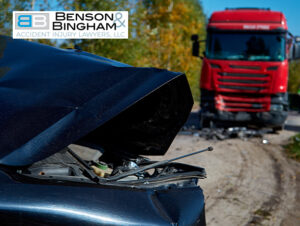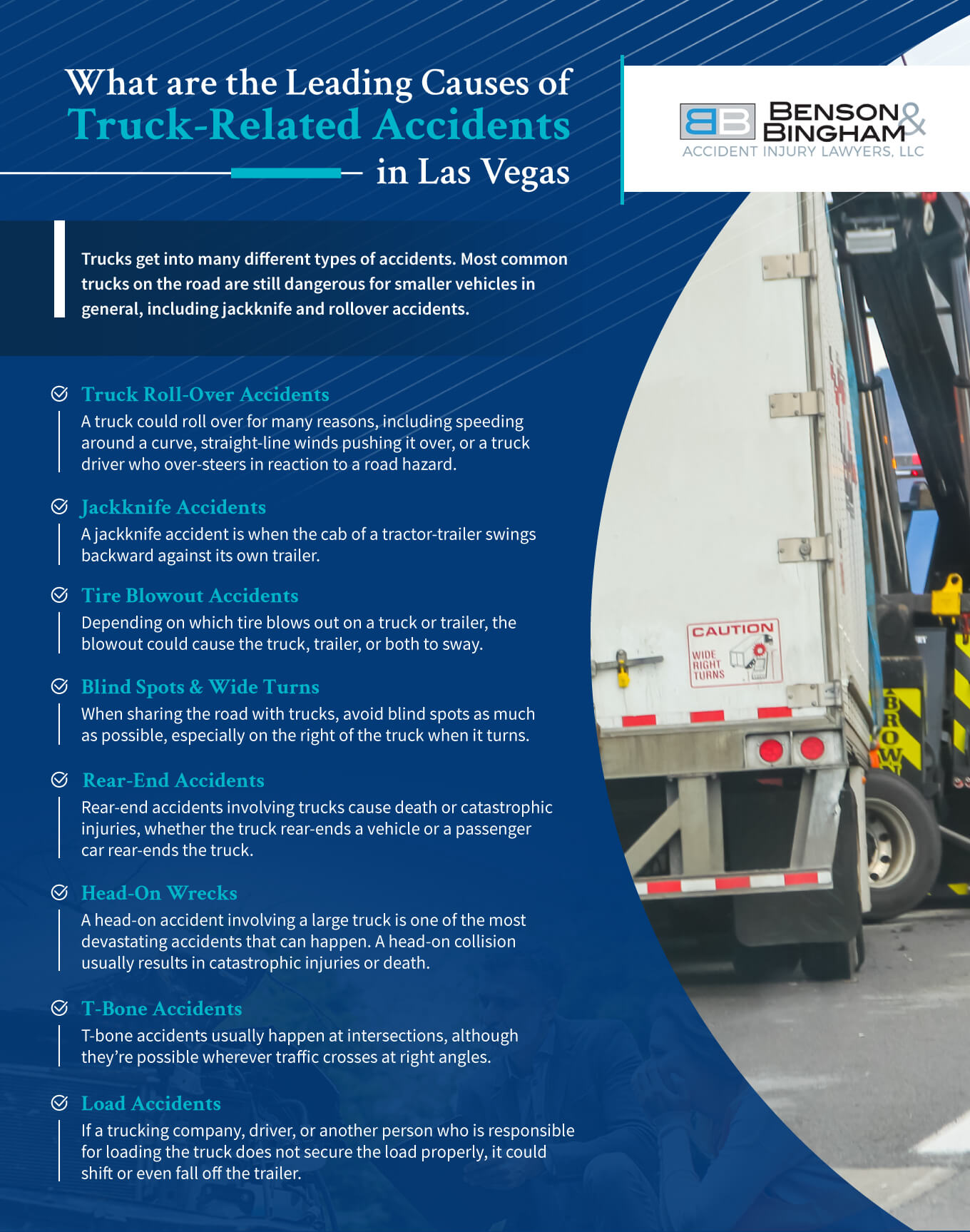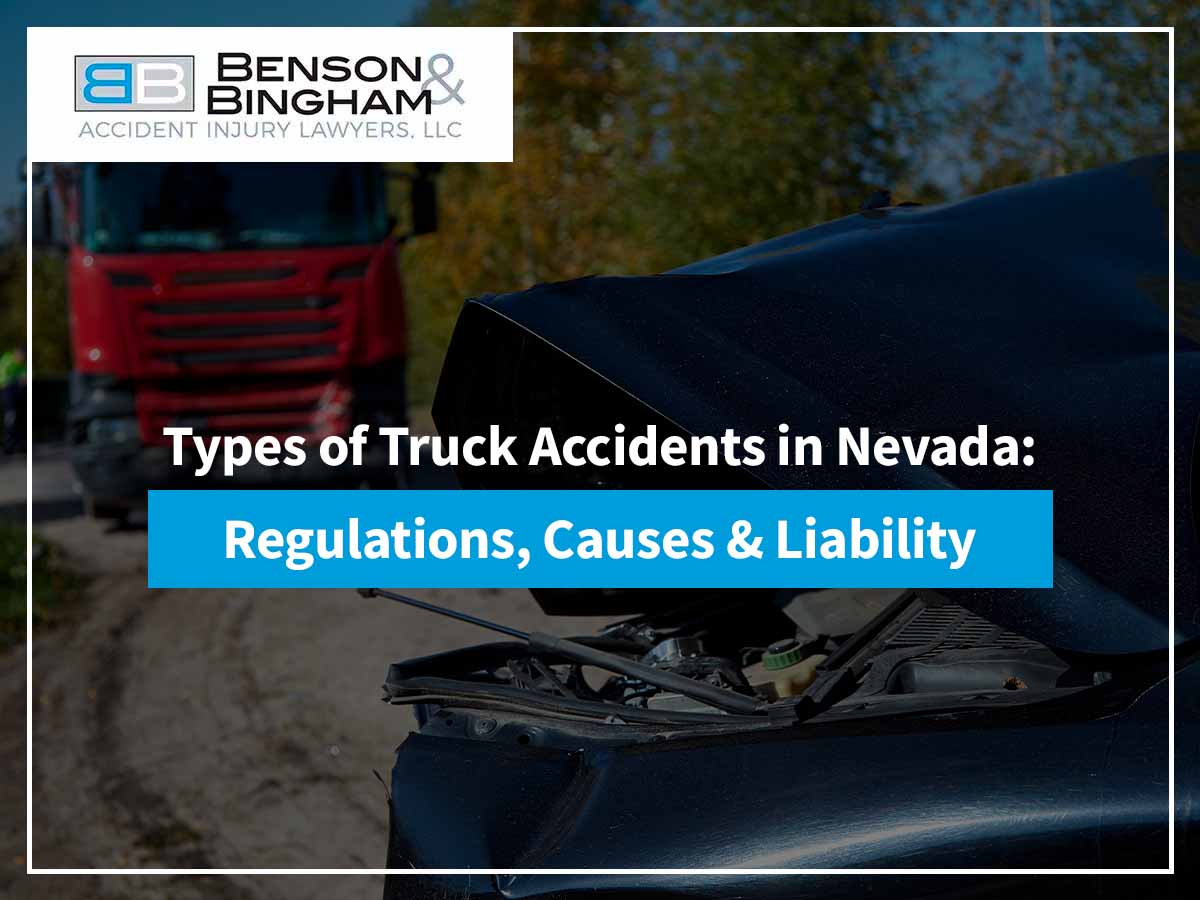How Does Nevada Law Work for Different Types of Trucks & Road Safety?
Large trucks have a lot of weight to move—and to stop. When they can’t, the consequences can be dire. Accidents involving trucks frequently cause catastrophic injuries or death, particularly when a heavy truck collides with a much smaller, lighter passenger vehicle. The disparity in size and weight between trucks and passenger cars means that the latter bear the brunt of the impact, often leading to severe trauma for the occupants. Victims of such accidents not only suffer physical injuries but also face emotional and financial distress. Medical bills can quickly accumulate, and if injuries are debilitating, the loss of income can add to the financial strain.
In these challenging times, a Nevada personal injury lawyer becomes a crucial ally. They can offer legal guidance, help navigate the complexities of liability and insurance claims, and work to secure fair compensation for medical expenses, lost wages, and other damages. Their expertise is especially valuable given the intricate web of federal and state regulations governing trucking operations, which can impact liability and compensation in the event of an accident.
Here are some facts about the types of truck accidents that occur on Nevada roads.
What Are The Most Common Trucks Seen in Nevada?

Understanding the different types of trucks and their specific functions is crucial for appreciating the complexities of road safety and logistics involved in trucking. Each type of truck, with its particular design and cargo, contributes differently to the dynamics of road use and requires specific considerations in terms of driving and safety protocols.
Tractor Trailers
Tractor-trailer trucks (also called “big rigs” or “semi-trucks”) can weigh up to 80,000 pounds fully loaded, and more if they are overloaded. They consist of an engine and cab, called a tractor, and a trailer with a hitch that attaches it to the tractor.
Trailers come in several forms:
- The box type. This type has double doors in the rear and is completely enclosed.
- The flat-bed. This type carries large equipment or strapped-down loads that would not fit in an ordinary box-type trailer.
- The low-boy. This trailer is also a flatbed, but it is low to the ground. It is designed to haul heavy equipment. The low-boy is often used to haul oversized loads such as large construction cranes or boats.
- The tandem trailer consists of two, usually box-type, connected trailers. Logistics companies like FedEx and UPS often haul goods in tandem trailers. Each trailer is the standard 48- or 52-foot box trailer, though the two of them hooked together have a combined length longer than a single box trailer.
- The house trailer. Tractors haul single sections of a house. These sections might be a single-wide trailer up to 15 feet wide or a section of a multi-part house up to 15 feet wide. The most common widths are 12 to 14 feet. Lengths vary, depending on the house. Most are longer than 40 feet.
Tractor trailers, especially the taller box trailers and the house trailers, have large blind spots one lane on the left, two lanes on the right, 20 feet in front of the truck and 30 feet behind the trailer. Keep in mind that if you cannot see the driver in the door mirrors of his or her truck, the driver cannot see you.
Box Trucks
Box trucks constitute the most common form of commercial delivery truck on the road. Some are as short as 8 feet while others are much longer—so long that they look like trailer trucks. Unlike a tractor-trailer, a box truck constitutes a single unit—the cab and cargo “box” are permanently attached. However, they share many similarities with tractor-trailers that can make them dangerous on the road. They are very heavy and have large blind spots. Also, because the “box” is permanently attached to the cab, box trucks need to make wide turns, which can create hazards for other vehicles, particularly vehicles to the right of trucks making a right-hand turn from an outside lane.
Industrial & Construction Trucks
You can tell an industrial truck by its looks. It’s usually large and dirty. The “box” is usually open at the top and has a gate that opens when the dump bed tilts up. Industrial or construction trucks are more dangerous in some ways and less dangerous in others. They have large blind spots, though not as large as those surrounding a tractor-trailer. In most cases, when turning right, they don’t need to make as wide of a turn as a typical box truck, but they can still put cars in danger when making a right turn from an outside lane.
The biggest danger of these trucks is their cargo. If they carry gravel, it could fly out of the top and hit your vehicle. If they are carrying sand or any other cargo and the back gate opens, the truck could dump a lot of its cargo right on the front of your car. Most construction trucks have a notice painted on the rear gate to keep back, sometimes as much as 200 feet, just because something is possibly falling off or the gate coming loose.
Tanker Trucks
If you see a truck with a round ‘tank’ on the back, that is a tanker and is usually carrying liquid (such as milk, oil, water, or even sewage) or liquified natural gas. Tanker trucks are weighty. In addition to the weight of the truck, you weigh the cargo. For example, a gallon of nitric acid weighs 10.58 pounds. A gallon of petroleum weighs 7.35 pounds. A gallon of distilled water weighs 8.33 pounds. A tank may range from about 1,000 gallons, such as those that deliver propane to homes up to 11,600 gallons for large tanks.
Tanker trucks present the same types of dangers on the road as ordinary tractor-trailer trucks, blind spots, turning radius, etc. Some cargo they carry also creates special hazards. In an accident, combustible contents of a tanker can explode, and toxic contents can release dangerous fumes that sicken people in surrounding areas. For this reason, tanker drivers usually have to carry special certifications to ensure they handle their cargo with extra care.
Emergency Vehicles
Many fire trucks and ambulances fit the large truck classification. Some may be on the smaller end of the scale and have a box shape. But others, like fire trucks, are quite long and have blind spots and turning radii similar to the largest box and tractor-trailer trucks. Emergency vehicles also have special privileges on the road.
Most people realize that when they hear sirens, they must pull off the road as soon as it is safe to give these trucks plenty of room to maneuver. Many states have “move over” laws that require drivers to move to the next lane on a highway or slow down considerably when passing emergency vehicles on the interstate. These laws not only keep you from running into emergency vehicles, but they protect the first responders so that they may safely do their jobs.

What are the Leading Causes of Truck-Related Accidents in Las Vegas
Trucks get into many different types of accidents. Most common trucks on the road are still dangerous for smaller vehicles in general, including jackknife and rollover accidents.
Truck Roll-Over Accidents
A truck could roll over for many reasons, including speeding around a curve, straight-line winds pushing it over, or a truck driver who over-steers in reaction to a road hazard. If a tractor-trailer rolls onto a car, the weight of it could flatten a car, even if the trailer is empty.
Jackknife Accidents
A jackknife accident is when the cab of a tractor-trailer swings backward against its own trailer. The trailer’s weight essentially pushes the cab from behind, usually when the driver has to slam on the brakes. A jackknifed trailer can plow into cars next to it and push them forward or even pin them between the truck and the trailer. If a car is small enough, the force of the accident may push the vehicle under the trailer.
Tire Blowout Accidents
A tire blowout is hard enough to handle on a passenger car, let alone a truck weighing tens of thousands of pounds. Depending on which tire blows out on a truck or trailer, the blowout could cause the truck, trailer, or both to sway. Once all of that weight starts swaying, it may be difficult for the driver to get the truck under control. The swaying truck and trailer could damage vehicles next to it by hitting them or it could even flip over on top of vehicles.
Blind Spots & Wide Turns
Because of the length of tractor-trailers, they need to make wide turns. If you pass the truck on the right while it turns right from an outside lane, the driver may not see you and could crush you with the trailer or force you off the road. A truck has deep and wide blind spots in the front and large spots down the sides of the truck and trailer and in the rear. When sharing the road with trucks, avoid blind spots as much as possible, especially on the right of the truck when it turns.
Rear-End Accidents
Rear-end accidents involving trucks cause death or catastrophic injuries, whether the truck rear-ends a vehicle or a passenger car rear-ends the truck. If a truck rear-ends a passenger vehicle, its size and weight risk crushing the smaller vehicle. If a passenger vehicle rear-ends a truck, it risks wedging under the truck. In either case, occupants of the smaller vehicle face a high risk of catastrophic injury and death.
Head-On Wrecks
A head-on accident involving a large truck is one of the most devastating accidents that can happen. A head-on collision usually results in catastrophic injuries or death. If a truck leaves its lane, it could cause a head-on crash. If one passenger vehicle is passing another on a two-lane road and returns to its lane fast enough, a truck may not have the time to slow down to avoid a head-on collision.
T-Bone Accidents
T-bone accidents usually happen at intersections, although they’re possible wherever traffic crosses at right angles. This type of accident happens when one vehicle fails to yield the right of way and runs into the side of another vehicle, or vice versa. Depending on the speed of the vehicles involved in a T-bone collision with a truck, a person in a passenger vehicle could suffer catastrophic injuries or even death.
Load Accidents
If a trucking company, driver, or another person who is responsible for loading the truck does not secure the load properly, it could shift or even fall off the trailer. A shifting load could cause the driver to lose control. A load that comes loose could fall off the trailer. If the trailer is a flatbed, the load could fall off either side or the rear of the trailer. If the trailer is a box, a shifting load could hit the rear doors hard enough to force the doors open and spill the cargo onto the roadway. All of these scenarios create significant dangers for other motorists.
What Are the Key Trucking Regulations in Nevada?
Nevada’s trucking regulations are essential for road safety, encompassing truck size and weight limits, mandatory rest periods for drivers, and regular inspections. These regulations aim to minimize accidents, ensuring that trucks are roadworthy and drivers are alert. For individuals involved in a trucking accident, consulting a Las Vegas car accident lawyer can be crucial for navigating these regulations in legal claims. This comprehensive regulatory approach is pivotal in upholding safety standards on Nevada roads.
Truck size
In Nevada, trucks must adhere to specific size regulations for safety and infrastructure compatibility. Trucks cannot be taller than 14 feet, wider than 8.5 feet, or longer than 70 feet. These dimensions are crucial to ensure that trucks can safely navigate under bridges, through tunnels, and on highways without posing a risk to other vehicles or infrastructure.
Weight Limits
Weight limits are a critical aspect of Nevada’s trucking regulations. Single-axle vehicles have a maximum weight limit of 20,000 pounds. Tandem-axle vehicles, which have two sets of axles, cannot exceed 34,000 pounds, and triple-axle vehicles have a limit of 42,000 pounds. These limits are important for maintaining road safety and preventing undue stress on road surfaces.
Driver Breaks
To combat driver fatigue, a significant factor in accidents, Nevada mandates specific break times for truck drivers. Drivers must take a 30-minute break every eight hours and a longer 10-hour break after a 14-hour shift. Additionally, they cannot drive for more than 11 hours during a 14-hour shift, ensuring they are well-rested and alert while driving.
Cargo & Truck Inspections
Regular inspections of trucks and their cargo are required to maintain safety standards. Drivers and trucking companies are responsible for inspecting the truck and its equipment before and during every trip. This includes checking for mechanical issues, cargo security, and compliance with safety regulations.
Commercial Driver’s License (CDL)
For operating heavier vehicles, drivers must possess a Commercial Driver’s License (CDL). This is mandatory for vehicles weighing 26,001 pounds or more, vehicles transporting 16 or more passengers, or vehicles used to transport hazardous materials. The CDL ensures that drivers have the specialized skills and knowledge necessary for safely operating large and potentially hazardous vehicles.
Who is Held Liable in Nevada Truck Accidents?

The parties that may be liable include:
- The truck driver
- The trucking company
- The truck owner
- The cargo loader
- The freight forwarding company
- The party at fault is important to determine when filing a truck accident lawsuit
Nevada law uses a doctrine called “modified comparative negligence”. This means that liability is spread out proportionally based on fault.
How To Identify Big Trucks’ Blind Spots
Large trucks have large blind spots, also known as “No Zones”, around the front, back, and sides of the vehicle. The largest blind spot is on the right side of the truck and can extend across two lanes of traffic. The blind spot directly behind a tractor-trailer can be at least 30 feet and can extend up to 200 feet. Additional key points to consider include:
- Understanding the “No Zone” Areas: Recognize that the areas directly in front, behind, and to the sides of a truck are often blind spots, where the truck driver cannot see other vehicles.
- Side Mirror Visibility: If you can’t see the truck driver’s face in their side mirror, assume you’re in a blind spot.
- Avoiding Side Blind Spots: Stay aware that the blind spots on the sides of a truck extend across several lanes. The right side blind spot is particularly large.
- Observing Truck’s Positioning: Be cautious when a truck is turning, as its blind spots shift and can obscure vehicles that are too close.
- Maintaining Safe Distance: Keep a safe distance when driving behind or in front of a truck to avoid the front and rear blind spots.
- Passing with Caution: When overtaking a truck, do so swiftly and safely to reduce the time spent in the truck’s side blind spot.
- Heightened Caution in Low Light: Be extra vigilant during dawn, dusk, or nighttime, as low visibility conditions can make it harder for truck drivers to notice vehicles in their blind spots.
- Watching for Truck Signals: Pay attention to a truck’s turn signals and brake lights for clues about the driver’s intentions, helping you stay out of blind spots.
- Being Wary at Intersections: Exercise caution at intersections, where trucks may make wide turns, significantly altering their blind spots.
- Respecting Truck’s Maneuver Space: Understand that large trucks need more room to maneuver, especially in urban areas, and adjust your driving accordingly to stay visible.
Need Legal Assistance After a Truck Accident in Nevada?
Facing complex legal challenges after such an incident calls for expert guidance. The attorneys at Benson & Bingham Accident Injury Lawyers, LLC are well-equipped to assist you. With extensive experience in handling truck accident claims, they advocate for your rights and interests, aiming to secure the maximum possible settlement. Whether the resolution involves negotiation or litigation, their team supports you throughout the process. Contact us today for a free, confidential consultation to explore your legal options and build a robust case tailored to your situation.


